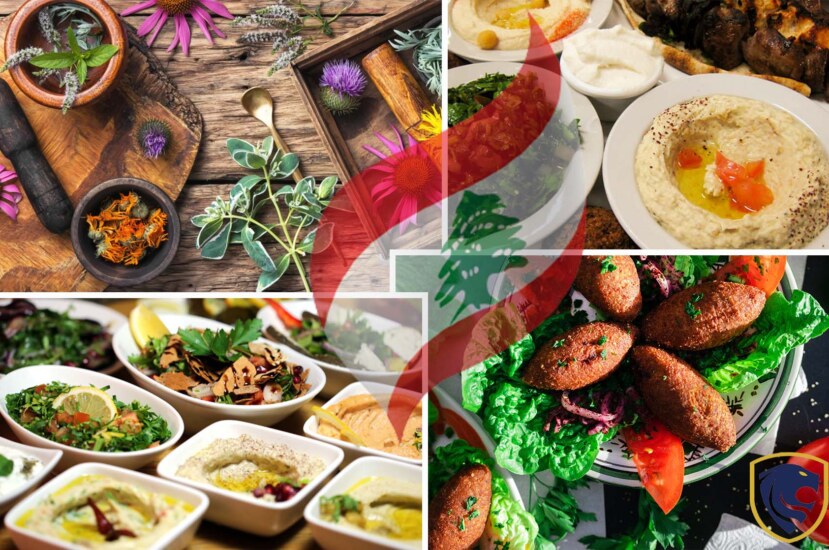Lebanese cuisine is a delectable blend of Mediterranean and Middle Eastern influences. It’s famous for its fresh ingredients, aromatic herbs, and hearty spices. Meals are frequently shared, demonstrating the country’s genuine hospitality. Aromatic spices and herbs infuse rich flavors into meals, resulting in a diversified and gratifying culinary experience. Cuisine in Lebanon incorporates both animal and plant-based dishes, catering to a wide range of dietary requirements. Lebanese food is a joyful journey of flavor and history, from savory meats cooked to perfection to colorful salads and dips.
Tabbouleh
Traditional Lebanese salads like tabbouleh are colorful and energizing dishes that capture the spirit of Lebanese cooking. origins of this food run to the Lebanon mountains. The main ingredients are bulgur wheat that has been soaked, tomatoes, mint, onions, and freshly chopped parsley. In addition, extra virgin olive oil and fresh lemon juice combine to make a flavorful dressing. Also, salt and pepper are used to season food. A lovely blend of flavors and textures may be found in tabbouleh. An attractive presentation is created by the vibrant green of the parsley and the vibrant scarlet of the juicy tomatoes. The salad is made fresher by the addition of zesty lemon juice and aromatic mint. The chewiness of bulgur wheat is satisfying. served as a side dish or as a mezze. enhances grilled meats and other traditional Lebanese dishes.

Tabbouleh; Exploring the Rich Culinary Heritage of Lebanon
it enhances grilled meats and other traditional Lebanese dishes. During the sweltering summer, tabbouleh is a popular option due to its mild and tangy profile. Its fame goes far beyond Lebanon’s boundaries. loved all over the world for its wholesome ingredients and flavor. Tabbouleh is a symbol of Lebanon’s long-standing culinary traditions. Tabbouleh is a dish you must taste, whether you eat it alone or as part of a Lebanese feast. Because it exemplifies the nation’s dedication to using fresh ingredients and flavorful sauces.
Hummus
The Middle East is where hummus, a Lebanese gastronomic gem, has its roots. It is a creamy and savory dip or spread that is made with mashed chickpeas, tahini, lemon juice, and garlic. Moreover, the origins can be traced to the Levant and ancient Egypt. A crucial component, chickpeas, have been grown in this area for thousands of years. In addition, Tahini, a paste formed from mashed sesame seeds, is added to hummus to give it a rich texture and nutty flavor. It is given acidic and aromatic properties by the addition of lemon juice and garlic. The top is frequently decorated with a drizzle of olive oil and a dusting of paprika or sumac to improve both its appearance and flavor. It is typically served as an appetizer or a snack with pita bread or raw veggies for dipping.

Hummus; Exploring the Rich Culinary Heritage of Lebanon
It shines as a condiment or side dish with falafel, shawarma, or grilled meats. Hummus has crossed international boundaries, becoming a favorite due to its delectable flavor and advantageous health properties. It’s a nourishing addition to any meal and is high in protein and fiber. It is a beloved component in Lebanese cuisine due to its creamy texture and balanced flavors. Hummus is a lovely representation of the long-standing culinary customs of Lebanon, whether it is served as a modest dip or the star of the meal. It invites diners to savor its straightforward but pleasing flavors and appreciate the rich history that has elevated this dish to fame on a worldwide scale.
Falafel
Falafel, a popular Lebanese delicacy, has a long history that goes back to the Middle East. It originated in ancient Egypt and made its way through the Levant before becoming a beloved staple of Lebanese cuisine. These fried orbs are made from ground chickpeas or fava beans. Herbs and spices like parsley, coriander, cumin, and garlic are among the ingredients. They’re formed into balls or patties and cooked till golden, creating a crunchy surface that gives way to a tender and aromatic interior. Falafel is a popular vegetarian option for people looking for plant-based treats.

Falafel; Exploring the Rich Culinary Heritage of Lebanon
It’s typically served in a warm pita bread pocket with tahini sauce, tomatoes, cucumbers, and pickles. The ultimate result is a balanced combination of textures and flavors. Falafel isn’t just for pita sandwiches. It’s also a staple of mezze spreads, often paired with hummus, tabbouleh, and other Lebanese favorite. Falafel has won international appreciation for its delicious flavor and adaptability. It caters to a wide variety of palates and dietary needs. Falafel epitomizes the essence of Lebanese cuisine, whether eaten as a street food snack or as part of a large Lebanese feast – a harmonic marriage of spices, herbs, and simple yet fulfilling ingredients. Its persistent appeal attests to its delectability and the long legacy of Lebanese culinary excellence.
Shawarma
Shawarma, a Lebanese gastronomic treat, has a heritage rooted in the rich traditions of the Middle East. In the Ottoman Empire, layered, spiced meat was first cooked on a vertical rotisserie. “Shawarma” is derived from the Turkish term “çevirme,” which means “turning” or “rotating.” Shawarma’s major ingredient is thinly sliced, marinated meat, usually lamb or chicken, but beef is also popular. Then these slices are meticulously placed on the vertical rotisserie and slowly roasted as they spin, yielding tender, delicious meat. A flavorful mixture of spices, including cumin, coriander, paprika, and garlic, is usually used to prepare shawarma.

Shawarma; Exploring the Rich Culinary Heritage of Lebanon
Pita bread or flatbread is frequently used to wrap shawarma, which is then topped with chopped fresh vegetables, tahini or garlic sauce, and occasionally pickles. The end product is a symphony of flavors and textures, with crisp veggies, creamy sauce, and delicate, smoked meat.
Shawarma has a distinct place in Lebanese street food culture and has gained global acclaim for its delectable taste and portable nature. It’s a popular quick bite or hearty supper that showcases the rich and aromatic flavors that are synonymous with Lebanese cuisine. Shawarma is a delightful voyage through Lebanese culinary tradition, whether served on a crowded Beirut street or in a Lebanese restaurant abroad.
Moussaka
Moussaka, a wonderful Lebanese dish, has a history that is intertwined with the Middle East’s unique culinary traditions. Its origins can be traced back to the Levant region, where it became famous as a filling and hearty dinner. Layers of eggplant, tomatoes, and seasoned ground meat, usually lamb or beef, make up moussaka. A creamy béchamel sauce binds the dish together, creating a rich and luscious texture. Moussaka celebrates the vivid flavors of the Mediterranean, with cinnamon and allspice permeating the meat filling. Every bite contains a symphony of flavors and sensations due to the ideal combination of ingredients. After assembling, the dish is baked until the flavors merge and the top develops a golden crust.

Moussaka; Exploring the Rich Culinary Heritage of Lebanon
Moussaka is a hearty and decadent dish that is frequently served as a centerpiece at family gatherings and special occasions. It represents the Lebanese culture of hospitality and charity, in which sharing a meal with family and friends is a treasured pleasure. While moussaka can be found in various Mediterranean cuisines, the Lebanese version stands out for its particular blend of spices and flavors. A plate of moussaka is not only a culinary joy. But also an investigation of Lebanon’s gourmet heritage’s rich history and unique tastes.




